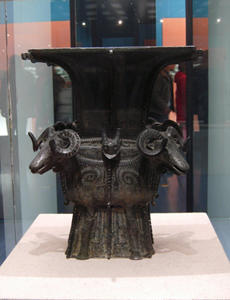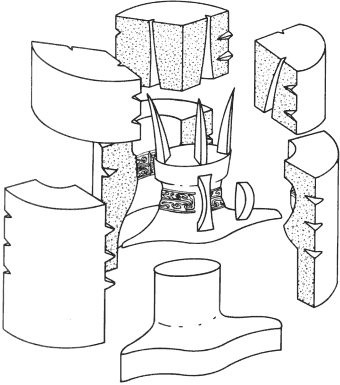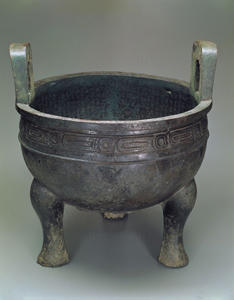Introduction
The Bronze Age is largely associated with the Neolithic age. Flad and Chen, argue that a given culture has a historical background that best explains their technological advancement. The two argue that requirements such as hunting and weaponry are best explained by such historical periods as the Bronze Age.
The discussion in this paper focuses on the Zhou and Shang dynasties (of ancient China) and their impact on the Bronze Age. The paper relies on the thesis statement that, “The cultural differences between the Shang and Zhou dynasties were essential in making the Bronze Age relevant.”
The paper provides a general overview of the Bronze Age in China. Details of the length of this historical period and the socio-economic impact are discussed. In the opinion of Flad and Chen, the Bronze Age was essential in improving China’s position as an advanced civilization.
Thus, details of the respective dynasty wars are outlined. The two are separately discussed to provide an opportunity to selectively determine the cultural disparity between the two dynasties. The paper further delves into the techniques applied in the craftsmanship of the Bronze Age. The vessels and their roles are also illustrated.
Historical accounts herald the Bronze Age of China as a spectacle in terms of human advancement. The discussions in this paper are arranged sequentially to ensure that the disparities of the two dynasties are properly outlined. In a research paper prepared by Liu and Chen an argument, suggesting the need for dominance by each dynasty, implies that art, religion and military power contributed to the difference in culture. The paper, therefore, concludes by providing a link between any cultural differences as far as art and religion are concerned.
The Bronze Age of China
Historical records suggest that the Bronze Age of China is a period of Chinese civilization which dates back to 2000 B. C. Researchers like Liu and Chen point out that the Bronze Age was brought about by the Shang dynasty. At the time, the Shang dynasty had their jurisdictions to include the found along the banks of the Yellow River. However, in contemporary times, the region constitutes what is popularly referred to as the Henan province of China.
In ancient times, the Chinese civilizations often explained most of their happenings by means of religious tales. Flad and Chen explain that during those days, the rulers derived their authority from glorious spirits. The implication was that such issues as warfare and general governance required involvement with the said spirits. In order to remain relevant both economically and militarily the rulers at the time, required to have the favor of the spirits.
One way of ensuring the said favor was guaranteed includes the offering of sacrifices. Flad and Chen, point out that at the times human sacrifices were offered to the gods and spirits. Bronze vessels, therefore, became a symbol of the spirits to which the sacrifices were offered. The Bronze Age Shang dynasty is characterized, largely with religious artifacts.
In ancient China, there existed supremacy battles among dynasties. The victor often took over leadership of a kingdom. To this end, the leadership of the Shang dynasty came to an end when they lost leadership to the Zhou dynasty. According to Ying, the battle between these two dynasties took place at around 1046 BC.
Upon their victory, their leadership of China is divided into two phases. There is the western and eastern Zhou. Notwithstanding the political differences that brought about the battle, there exist certain similarities between these two dynasties. The same explains the existence of certain vessels
During the reign of the Zhou dynasty, there are elements of religion and warfare which characterize the Bronze vessels. Contrary to the human sacrifices carried out during the reign of the Shang dynasty, archeological findings indicate a reduced number.
During the Shang regime, Bronze continued to be used for the production of royal vessels. Ying argues that Zhou craftsmen started to use bronze vessels to create inscriptions of the achievements of their kings. Other bronze vessels include idols of spiritual connotations of the gods to whom the sacrifices were offered.
Shang Dynasty
The Bronze Age of traditional China is highlighted by the reign of the Shang Dynasty. There are written records and archeological findings suggests that details of the Bronze Age are largely contributed to by this dynasty.
However, there is a dispute as to the number of dynasties that existed prior to the Shang dynasty. There are scholars who argue that the Shang Dynasty is the third to have exercised leadership of the areas along the Yellow River. That notwithstanding, the technological advances associated with the Bronze Age, were largely contributed by the Shang Dynasty.
Every time one requires proof of existence, it is upon the archeological findings of such items as scrolls carving and even fossils. According to Flad and Chen, most of the information about the Shang dynasty was passed on in form of narratives. The big break occurred when vessels with Bronze inscriptions were found. Some of the vessels discovered were made entirely of bronze and contained information about how the Kings used to appease the gods.
The production of bronze vessels required highly skilled personnel. To date there are only two main methods of casting bronze which were known to be in use during the reign of the Shang dynasty. The two methods are the lost wax method and the piece-mold casting. As suggested by the name, the lost wax method required that the original sculpture be made of wax upon which its mold would be created.
In the process of making the final copy of the object in bronze the mold would be destroyed. The piece-mold casting, on its part, is believed is much older. The same has been confirmed by findings of various archeological artifacts. Most of the traditional Chinese sculptures were created by means of piece-mold casting.
Whenever a civilization wants to have a standard which can be used as a point of reference for posterity, they come up with a single masterpiece. For instance, the Egyptians are famous for the pyramids of Giza. In a similar fashion, the Shang dynasty also had a phenomenal reference point to the Bronze Age. According to Flad and Chen, one of the most well known artifacts associated with the bronze vessels of Shang dynasty was the taotie.
Taotie is the type of ornament, based on the images of animals and birds that are present on Shang bronzes. Taotie has eyes and had a structure which was representative of a mystical creature while still retaining the aesthetics of an ornament, or vessel. Figure 1 is an illustration one of the vessels associated with the Shang Dynasty.

The square zun illustrated in figure 1 is among the royal vessels which were associated with the Shang Dynasty. Presently, the vessel is located at the national museum of China. As shown in the illustration, the vessel has carvings of a goat head on its corners.
Based on the consistency of the creature and the detail to suggest mystic powers, scholars were able to associate the vessel with the taotie associated with the Shang dynasty. As mentioned earlier, there are other cultural practices like war which have contributed to the existence of other vessels with a similar design.
Bronze Age Casting
During the Bronze Age, bronze was used to make a wide assortment of weapons, tools and vessels used in religious rituals. As mentioned earlier, this skill required personnel with sufficient mastery of smelting and forming objects.
Yunxiang argues that such craftsmen were rare and that explains why there is uniqueness in most of the bronze vessels. The casting of objects using bronze can be dated back to China as early as 1300 BC. Several artifacts suggest that the fabrication was carried out by appropriate percentages of the constituents in the alloy.
Bronze is an alloy that is made up of a mixture of two metals. In most common cases the mixture is between copper and tin. However, there are exceptional cases when the lead is added to the mixture. The metallic nature of the constituents implies that high amounts of heat are essential for the formation of the bronze alloy.
The study by Jin fund that both the Zhou and Shang dynasties employed casting by means of clay (see figure 2). However, the technique employed by the Shang society differed slightly to that of the Zhou. In the former’s case, there were removable section molds while the same was absent in the latter.

Initially, the desired vessel is made out of clay and given an extra coating of clay for stability and allowed to dry. The inner mould is the separated from the outer clay to create a hollow space where the molten bronze is to be poured. There are different accounts on how the practice was carried out in the earlier dynasties.
However, the Zhou dynasty sustained this type of casting method since the vessels would have stronger properties. Once the molten Bronze cools and solidifies, the clay is broken off to reveal the bronze vessel as illustrated in figure 2. The emergent product is then polished to improve its aesthetic value.
As mentioned earlier, the vessels can be produced through a unique type of casting known as the wax-lost. According to Ying, this casting technique was advanced by the Shang dynasty. The vessels that emerged out of this kind of casting technique had smoother a smoother finish. Examples of notable artifacts cast using this kind of method includes the bronze vessels found from the Zend Hou Yi tomb. The Shang dynasty is also know to be responsible for the overall casting which is associated with the peak of the Bronze Age.
Zhou Dynasty
As mentioned earlier, the Zhou dynasty succeeded the reign of the Yellow River from the Shang dynasty. Culturally, the Zhou were seen as opportunists. Flad and Chen argue that one way of establishing their legitimacy was through the adoption of cultures from their predecessors.
There are several archeological findings which support the cultural opportunism exhibited by the Zhou in the areas of art and weaponry. Considering the bronze technology, there is a lot of technique which was borrowed from the Shang dynasty. A look at artifacts from the two dynasties reveals that in both cases, the design and inscriptions shared similarities. That notwithstanding, there were certain modifications which made the Zhou bronze vessels more pronounced
The Zhou dynasty was largely associated with religious activities. The same explains why vessels associated with this error are largely associated with rituals that weaponry or tools. The success of the Zhou dynasty is attributed to their application of religious rituals to pacify regions that were in conflict.
At the start of the 19th century most of the said rituals underwent tremendous changes. For instance, there was a decrease in the use of wine vessels. At the time, most of the people preferred the use of food basins, locally referred to as gui. Consequently, the vessels meant for rituals were made with more attention to the details.
As the society advanced in terms of civilization, certain changes in their religions were also affected. According to Ying, the society shifted from using oracle bones for divination to observing changes in nature. In response to this change, there was also a shift in the type of vessels used.
Newer and more sacred vessels were created for the new religious practices. For many years after assuming control, the Zhou relied on religion to advance their political patronage over the masses. Consequently, the bronze vessels of the era had more religious inclinations.
During the reign of the Zhou dynasty, the Anyang people were the appointed craftsmen. The skill was often passed on from one generation to another. The most notable vessel during the Zhu dynasty’s reign was the long tailed bird believed to have mystical powers from the gods.
Initially, the Shang was known for such shapes as the Gu and Gong. However, the spiritual differences with the Zhou dynasty saw these shapes phased out by the new craftsmen in the Zhou era. The famous taotie of the Shang era was also phased out and replaced by meander patterns on the side of the vessel. The taotie used on the side of the vessel, in the Zhou era, was used for creating inscriptions. Most of the archeological findings of vessels from that era are identified using the said inscriptions.
The craftsmen of Zhou made their vessels by inserting a special core to create a cavity inside of the vessel. This core was engraved with writings which were a narrations of the various fetes achieved by the ruling class at the time. The master of their trade was evident when the findings were discovered thousands of years later and could still be read.
As mentioned earlier, most of the vessels in the Zhou era were unique owing to the habit of including inscriptions either on the inner or outer part of the vessel. According to Yunxiang, the inscriptions were seen as a record of events within the kingdom which were then reported to the gods. Figure 3 illustrates an example of a notable vessel during the Zhou reign. The Cauldron of Mao has very long inscriptions.

As illustrated in figure 3, the inscriptions are placed on the inner part of the vessel. A study by Liu and Chen suggests that, at the time, most of the inscriptions were kept at around 400 characters. However, the Cauldron of Mao is known to have a total of 499 characters. The scholars attribute the length of the message to the detail that was often factored in the casting process. Overall, the Zhou dynasty made great strides in promoting the Bronze Age.
Other notable vessels include mirrors and bells. Most of these vessels were largely associated with the praise of the gods or edification of the kings. However, as opposed to the Shang period, the Zhou era is characterized with more factual ornaments to the vessels. Gone were the abstract creatures that were the hallmark of the Shang dynasty.
Conclusion
Having looked at the respective periods, it is apparent that there was a similar notion shared by each dynasty. According to Gang, the two periods of the Bronze Age, were characterized by differences in the patterns and ornaments attached to the vessels. The scholar attributes the said differences to by the influence of silk and fabric embroidery that has developed during Zhou period.
Consequently the vessels of Zhou have less abstract patterns. As opposed to the Shang era, the creatures in the Zhou dynasty are easily recognized. The images on the vessels are more pronounced. The most notable difference between the vessels in the Zhou era and those in the Shang is the attempt to place human images. The same can be attributed to the obsession with the royalty at the time.
Bibliography
Flad, Rowan, and Chen Pochan. Ancient Central China: Case Studies in Early Societies. Cambridge: Cambridge University Press, 2013.
Gang, He. “A Study on Taotie and Human Sacrifices Humanity in Ancient China” Journal of South East Culture no. 7(2002): 50-60.
Jin, Wang. “An introduction on the Casting Technique of the Zenghouyi Zun-Pan.”Journal of South East Culture no. 1 (2002): 70-74.
Liu, Li, and Chen Xing-Can. “The City: The Controlled Problem of the Natural Resources in the Xia-Shang Period.” Journal of South East Culture no. 3 (2000): 34-45.
Ying, Wang. Bronze Age China: Style and Material. Cambridge: Cambridge Scholars Publishing, 2010.
Yunxiang, Bai. “A Study on Chinese Primal Bronze Wares and the Origin of Bronze Wares.” Journal of South East Culture no. 7(2002): 25-37.